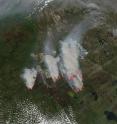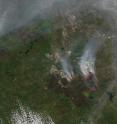Fort McMurray fires cause air quality issues
Related images
(click to enlarge)
The air quality around the entire Fort McMurray region remains very poor. The Alberta Health Services has issued warnings for the entire area with Health Quality Index of 10+ (very high risk of triggering health issues) reported in the area. As evidenced in these images from the morning and evening passes of the Terra and Aqua satellites respectively, huge amounts of smoke are still billowing into the atmosphere. The Alberta Health Services has issued an air-quality advisory for the Fort McMurray area, as well as a precautionary air-quality advisory for Edmonton and communities in the North Zone due to wildfires. Real-time air-quality data and information is available at: http://www.environment.alberta.ca/apps/aqhi/aqhi.aspx. Current fire conditions are high to extreme in northeastern Alberta. The Fort McMurray fire remains out of control and is estimated to cover 522,892 hectares (2019 sq. miles), including 2,496 hectares (almost 10 sq. miles) in Saskatchewan. A total of 17 wildfires are burning but only the Fort McMurray fire remains out of control.
The Government of Alberta website reports there are 1,989 firefighters, 88 helicopters, 253 pieces of heavy equipment and 25 air tankers currently battling the fires. Fort McMurray, Anzac, Gregoire Lake Estates, Fort McMurray First Nation and Fort McKay First Nation remain under a mandatory evacuation order.
This natural-color satellite image was collected by the Moderate Resolution Imaging Spectroradiometer (MODIS) aboard the Aqua and Terra satellites on May 24, 2016. Actively burning areas, detected by MODIS's thermal bands, are outlined in red. NASA image courtesy Jeff Schmaltz, MODIS Rapid Response Team. Caption: NASA/Goddard, Lynn Jenner with information from the Alberta Government website.
Source: NASA/Goddard Space Flight Center
Other sources
- Image: Clear skies give way to Fort McMurray blazefrom PhysorgFri, 27 May 2016, 13:31:00 UTC
- Fort McMurray fires cause air quality issuesfrom PhysorgThu, 26 May 2016, 6:11:17 UTC
- Fort McMurray wildfire ash reaches all the way to Spainfrom CBC: Technology & ScienceWed, 25 May 2016, 21:21:07 UTC
- Smoke in Spain: Fort McMurray wildfire ash reaches Europefrom CBC: Technology & ScienceWed, 25 May 2016, 20:50:57 UTC

